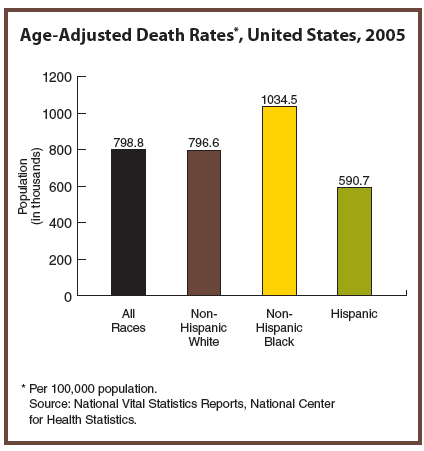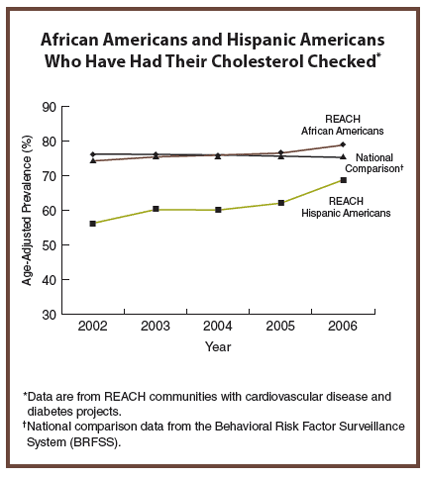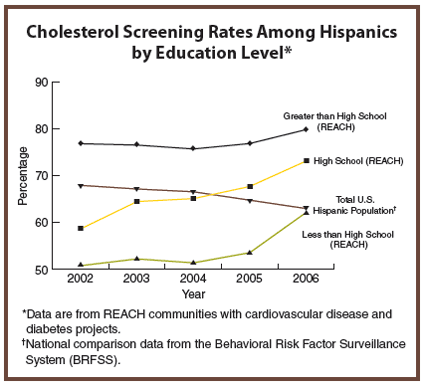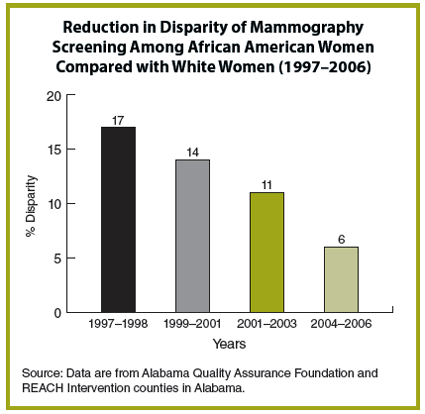 |
|
 |
 |
 |
Racial and Ethnic Approaches
to Community Health (REACH U.S.)
Finding Solutions to Health Disparities
At A Glance 2009

Racial and Ethnic Disparities in Health: The Facts
Despite great improvements in the overall health of the nation,
health disparities remain widespread among members of racial and ethnic
minority populations. Members of these groups are more likely than
whites to have poor health and to die prematurely, as the following
examples illustrate:
- African Americans. Although breast cancer is diagnosed
10% less frequently in African American women than in white women,
African American women are 34% more likely to die of the disease.
African American adults are 1.9 times more likely than non-Hispanic
white adults to have been diagnosed with diabetes. Although African
American children aged 19 to 35 months had comparable rates of
immunization for hepatitis, influenza, MMR (mumps-measles-rubella),
and polio, they were slightly less likely to be fully immunized
compared with non-Hispanic white children. In 2004, African
Americans had asthma-related emergency room visits 4.5 times more
often than whites. In 2005, non-Hispanic blacks were almost twice as
likely as non-Hispanic whites to die of viral hepatitis.
- American Indians and Alaska Natives. American Indian and
Alaska Native adults are 2.3 times more likely than white adults to
be diagnosed with diabetes. American Indian women are 1.7 times more
likely to die of cervical cancer than white women. In 2005, American
Indians/Alaska Natives aged 18 to 64 years were slightly more likely
than non-Hispanic whites to have received the influenza (flu) shot
in the past 12 months. In 2006, American Indian/Alaska Native adults
were 60% more likely than non-Hispanic whites to be diagnosed with
asthma. Infant mortality rates among American Indians/Alaska Natives
are 1.4 higher than among non-Hispanic whites.
- Asian Americans. Rates of cervical cancer among
Vietnamese American women are higher than rates among any other
ethnic group in the United States—5 times higher than non-Hispanic
white women. Although rates of asthma are generally lower among
Asian Americans than among white Americans, in 2003, asthma-related
deaths were 50% higher among Asian Americans.
- Hispanics/Latinos. In 2004, Hispanic women were twice as
likely as non-Hispanic white women to be diagnosed with cervical
cancer. Although Hispanic children aged 19 to 35 months had
comparable rates of immunization for hepatitis, influenza, MMR, and
polio, they were slightly less likely to be fully immunized compared
with non-Hispanic white children.
- Native Hawaiians/Pacific Islanders. In Hawaii, the rate
of diabetes among Native Hawaiians is more than twice the rate among
whites. Native Hawaiians are 5.7 times more likely to die of
diabetes than whites living in Hawaii.

[A text description of this
graph is also available.]
CDC’s Leadership Role
For years, public health officials, program managers, and policy
makers have been frustrated by the seemingly intractable problem of
health disparities and have been at a loss for solutions. In response,
CDC created Racial and Ethnic Approaches to Community Health (REACH
U.S.), a program that continues to demonstrate that health disparities
can be reduced and the health status of groups most affected by health
inequities can be improved. REACH supports CDC’s strategic goals by
addressing health disparities throughout infancy, childhood,
adolescence, adulthood, and older adulthood. This program has developed
innovative approaches that focus on racial and ethnic groups and is
improving people’s health in communities, health care settings, schools,
and work sites.
REACH U.S. supports community coalitions that design, implement,
evaluate, and disseminate community-driven strategies to eliminate
health disparities in key health areas. In Fiscal Year 2008, Congress
allocated almost $34 million to support the REACH program. CDC provides
training, technical assistance, and support to REACH communities to help
them understand social determinants of health—resources that contribute
to the length and quality of life of individuals by their distribution
across populations—and their relationship to health disparities. As a
result, REACH communities empower community members to (1) seek better
health; (2) serve as catalysts for change to local health care
practices; and (3) mobilize communities to implement evidence-based
public health programs that address their unique social, historical,
economic, and cultural circumstances.
Data Show REACH is Working
Data from the REACH Risk Factor Survey show that the REACH program is
helping people to significantly reduce their health risks and manage
their chronic diseases.
This survey assesses improvements in health-related behaviors and
reductions in health disparities within REACH communities, which focus
on breast and cervical cancer prevention, cardiovascular health, and
diabetes management. Survey results include the following:
- Over a 4-year period, the cholesterol screening rates for
Hispanics of all educational levels in REACH communities have
steadily increased. In fact, the cholesterol screening rate for
Hispanics in REACH communities with a high school education, which
was previously below the rate for the national Hispanic population,
has surpassed the national rate for this population. Hispanics with
less than a high school education in REACH communities now have
rates that are approaching that of all Hispanics nationally.
- In 2002, the percentage of African Americans in REACH
communities who were screened for cholesterol was below the national
average. By 2006, this percentage exceeded the national average.
- Since 2002, the cholesterol screening rate for Hispanics in
REACH communities has greatly improved, quickly catching up to the
national average. The cholesterol screening rate for Hispanics from
REACH communities increased by 18% during 2002–2006.

[A text description of this
graph is also available.]
The Keys to Success
REACH has identified the following key principles and supporting
activities for effective community-level work to reduce health
disparities in racial and ethnic minority communities across the United
States:
- Trust. Build a culture of collaboration with communities
that is based on trust.
- Empowerment. Give individuals and communities the
knowledge and tools needed to create change by seeking and demanding
better health and building on local resources.
- Culture and History. Design health initiatives that are
grounded in the unique historical and cultural context of racial and
ethnic minority communities in the United States.
- Focus on Causes. Assess and focus on the underlying
causes of poor community health and implement solutions that will
stay embedded in the community infrastructure.
- Community Investment and Expertise. Recognize and invest
in local community expertise and motivate communities to mobilize
and organize existing resources.
- Trusted Organizations. Enlist organizations within the
community that are valued by community members, including groups
with a primary mission unrelated to health.
- Community Leaders. Help community leaders and key
organizations forge unique partnerships and act as catalysts for
change in the community.
- Ownership. Develop a collective outlook to promote shared
interest in a healthy future through widespread community engagement
and leadership.
- Sustainability. Make changes to organizations, community
environments, and policies to help ensure that health improvements
are long-lasting and community activities and programs are
self-sustaining.
- Hope. Foster optimism, pride, and a promising vision for
a healthier future.
Future Directions
REACH communities are demonstrating that health disparities among
racial and ethnic minority groups can be reduced and effective
strategies can have their greatest impact in low-income communities. CDC
will use the ongoing successes of proven strategies to influence health
care practices and polices throughout the public health system. In
addition, it will fund at least 36 legacy communities to spread
effective strategies to communities across the nation. Legacy
communities will be funded as part of the Centers of Excellence in the
Elimination of Health Disparities (CEED), and they will receive
mentoring and support from CEED. CDC and REACH communities also will
continue to collaborate to analyze local data and evaluate program
strategies.

[A text description of this
graph is also available.]
Back to top
Success Stories
Alabama: REACHing African American women in rural
Alabama and across the Mid-South
In Alabama—and across the United States—African
Americans are more likely to die of cancer than white Americans. In
certain Alabama counties, more African American women die of breast
cancer than white women. Additionally, the percentage of African
American women aged 65 years or older who reported receiving a
Papanicolaou test (Pap test) decreased within the past 3 years.
With support from CDC, the Alabama Breast and Cervical
Cancer Coalition at the University of Alabama at Birmingham has engaged
a variety of stakeholders, key leaders, and concerned citizens from
community- and faith-based organizations, state health departments,
grassroots agencies, and public and private health care organizations to
promote awareness of and increase participation in breast and cervical
cancer screening services in selected counties throughout the state. A
core group of volunteers including trained community health advisors,
nurses, other health care professionals, and clergy routinely
disseminate culturally appropriate health information. They also conduct
community-based outreach efforts to eliminate barriers for women
navigating the complex health care system.
In Choctaw County, African American women were much less
likely to get mammography screening compared with white women. During
1997–2006, the percentage of African Americans who received mammography
screenings increased from 29% to 61%, surpassing by 13% the rate for
white women who were screened.
During approximately the same time period in Dallas
County, a lower mammography screening rate among African American women
(30%) compared with white women (50%) was almost eliminated. According
to data from the eight-county Alabama REACH program focus area, the gap
in mammography screening rates between African American and white women
decreased by 76%.
California: REACHing African Americans in Los Angeles
In South Los Angeles (L.A.) County, the age-adjusted
death rates from heart disease and diabetes among African Americans are
much higher compared with rates for Los Angeles County as a whole. Few
resources exist, however, to support a healthy lifestyle for residents
of South L.A. neighborhoods.

[A text description of this
graph is also available.]
Community Health Councils of Los Angeles (CHC LA)
completed a study on food choices in neighborhood supermarkets, grocery
stores, and restaurants and examined resources for physical activity.
The study’s findings revealed differences in the availability and
quality of supermarkets and grocery stores found in South L.A. compared
with L.A. County as a whole. Fewer markets serve more people in South
L.A.—5,957 persons per store in South L.A. compared with 3,763 persons
per store in L.A. County. The study also noted differences in the
availability of healthy food choices.
CHC LA assembled a cross section of key stakeholders to
form the African Americans Building a Legacy of Health (AABLH)
coalition. This coalition works to promote healthy communities and
reduce disparities in the rates of diabetes, heart disease, and stroke
among African Americans living and working in South L.A. In 2006, the
AABLH coalition found that only 41% of stores in South L.A. sold fresh
produce compared with 71% of stores that sold fresh produce in L.A.
County. A 2005 AABLH study also reported an abundance of fast-food
restaurants in South L.A. Of the total restaurants in South L.A., 25.6%
are fast food; of the total restaurants in L.A. County, only 11.2% are
fast food.
An examination of opportunities for adult African
Americans to engage in physical activity revealed that 35% of physical
activity venues in L.A. County offer adult physical activity compared
with 11% of similar venues available in South L.A. Adult physical
activity opportunities were offered in 58% of L.A. County communities
compared with 27% in South L.A. communities. These findings reveal
resource inequities and inaccessibility factors that contribute to
health disparities.
With CDC support, Community Health Councils of Los
Angeles has engaged a multi-sector consortium to research and evaluate
strategies to (1) promote land-use management and urban design policy,
(2) increase physical activity opportunities and improve existing food
venues through regulatory practices and policy development, and (3)
develop policies and promote investments that support new nutrition
sources.
Environmental improvements are beginning to take shape.
The Community Redevelopment Agency of Los Angeles has developed an
incentive package to attract grocery stores and sit-down restaurants to
under-resourced communities. The Los Angeles City Council unanimously
approved a proposal that would prohibit new fast-food restaurants in
Council Districts 8 and 9 in South L.A. for at least 1 year.
South Carolina: REACHing African Americans in
Charleston and Georgetown Counties
In South Carolina, African Americans are at greater risk
than whites of developing diabetes and are at greater risk of developing
diabetes-related complications such as heart disease, stroke, blindness,
renal failure, and the need for an amputation. Diabetes is the sixth
leading cause of death in South Carolina, claiming more than 1,600 lives
each year.
The Medical University of South Carolina and the REACH
Charleston and Georgetown Diabetes Coalition conducted a community needs
assessment to improve diabetes self-management. The Coalition discovered
that people with diabetes had high interest in using the Internet to
find important information about managing their diabetes. However, 50%
of older community members and 40% of people with less than 12 years of
formal education needed help using the Internet. The coalition built a
library partnership to support and sustain diabetes education across the
community. The library partnership promotes use of online health
information in the context of support systems already in place for the
African American community.
Other strategies included creating walk-and-talk groups,
providing diabetes medicines and supplies, creating learning
environments where health professionals and persons with diabetes learn
together, offering advice on how to buy and prepare healthier foods, and
improving the quality of diabetes care.
Other disparities for African Americans with diagnosed
diabetes have been greatly reduced. For example, during a 5-year time
span, the percentage of African Americans who had their hemoglobin A1C
(blood sugar) levels checked annually increased from 77% to 97%.The
percentage who had their blood cholesterol level checked increased from
47% to 81%. Kidney testing increased from 13% to 53%, and foot exams
increased from 64% to 97% in the same time frame.
Lower-extremity amputations among African Americans with
diabetes also have decreased sharply. For example, in Charleston County,
the percentage of amputations among African American males with diabetes
who were hospitalized decreased by almost 54% over a 7-year time span.
In Georgetown County, the rate of amputations for this same group
decreased 54% over a 3-year time period.
Back to top
Related Materials
Back to top
|
For more information please contact
Centers for Disease Control and Prevention
National Center for Chronic Disease Prevention and Health Promotion
4770 Buford Highway NE, Mail Stop K–45, Atlanta, GA 30341-3717
Telephone: 770 488-5269 • E-mail:
cdcinfo@cdc.gov • Web:
http://www.cdc.gov/reach
|
|
 One or more documents on this Web page is available in Portable Document Format
(PDF). You will need Acrobat
Reader (a free application) to view and print these documents.
One or more documents on this Web page is available in Portable Document Format
(PDF). You will need Acrobat
Reader (a free application) to view and print these documents.
Page last reviewed: March 30, 2009
Page last modified: March 30, 2009
Content source: National Center for
Chronic Disease Prevention and Health Promotion
|
 |
![]() One or more documents on this Web page is available in Portable Document Format
(PDF). You will need Acrobat
Reader (a free application) to view and print these documents.
One or more documents on this Web page is available in Portable Document Format
(PDF). You will need Acrobat
Reader (a free application) to view and print these documents.